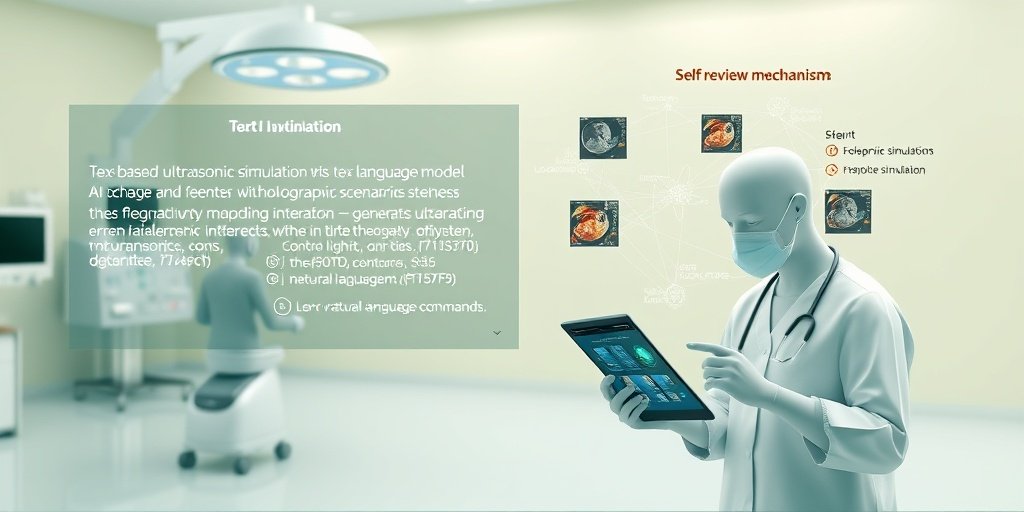⚡ Quick Summary
This study introduces a novel text-based simulation control architecture for ultrasonic simulation systems, utilizing a large language model (LLM) and ground artificial intelligence (AI) to enhance accessibility and efficiency. The proposed method reduces simulation configuration time by approximately 75% and significantly lowers scenario generation error rates from 23.89% to 1.48%.
🔍 Key Details
- 📊 Technology Used: Large Language Model (LLM) and Ground AI
- ⚙️ Application: Ultrasonic simulation systems
- ⏳ Time Reduction: Average simulation configuration time decreased by 75%
- 📉 Error Rate Improvement: Scenario generation error rate reduced from 23.89% to 1.48%
🔑 Key Takeaways
- 🤖 AI Integration: The study highlights the potential of AI-driven methods in simulation frameworks.
- 💡 Modular Approach: Functionalities of the SimNDT program were modularized for better command interpretation.
- 🌐 Natural Language Processing: Users can control simulations using natural language commands.
- 🏆 Multi-Agent Collaboration: The use of multiple LLM agents enhances task completion rates.
- 💰 Cost Efficiency: The advancements could lead to reduced operational costs in simulation processes.
- ⏱️ Time-Sensitive Applications: Particularly beneficial for applications like digital twin systems.

📚 Background
Traditional ultrasonic simulation systems often rely on complex graphical user interfaces (GUIs) or scripting, which can be time-consuming and challenging for new users. The need for a more accessible and efficient method has become increasingly apparent, especially in fields requiring rapid simulation capabilities.
🗒️ Study
This study proposes a groundbreaking approach to ultrasonic simulation control by leveraging a large language model and ground AI techniques. By breaking down the functionalities of the SimNDT program into discrete, manageable functions, the researchers aimed to simplify the user experience and enhance the overall efficiency of simulation processes.
📈 Results
The implementation of the proposed text-based control architecture resulted in a remarkable 75% reduction in average simulation configuration time. Furthermore, the introduction of self-review mechanisms and multi-agent collaboration led to a significant decrease in scenario generation error rates, from 23.89% to 1.48%, showcasing the reliability of the new system.
🌍 Impact and Implications
The findings of this study have profound implications for the future of ultrasonic simulation systems. By integrating AI-driven methods, the proposed architecture not only enhances accessibility for new users but also significantly improves operational efficiency. This could pave the way for broader applications in various fields, particularly in time-sensitive environments such as digital twin systems.
🔮 Conclusion
This research underscores the transformative potential of AI in enhancing the functionality and accessibility of ultrasonic simulation systems. The significant reductions in configuration time and error rates highlight the promise of integrating text-based control and ground AI mechanisms. As we move forward, further exploration of these technologies could lead to even greater advancements in simulation frameworks.
💬 Your comments
What are your thoughts on this innovative approach to ultrasonic simulation? We would love to hear your insights! 💬 Leave your comments below or connect with us on social media:
Artificial intelligence orchestration for text-based ultrasonic simulation via self-review by multi-large language model agents.
Abstract
Widely used ultrasonic simulation systems often rely on complex graphical user interfaces (GUIs) or scripting, resulting in substantial time investments and reduced accessibility for new users. In this study, we propose a novel text-based simulation control architecture, which leverages a large language model (LLM) and the ground artificial intelligence (AI) approach to streamline the control of ultrasonic simulation systems. By modularizing the functionalities of the SimNDT program into discrete functions and enabling natural language-based command interpretation, the proposed method reduces the average simulation configuration time by approximately 75%. To further mitigate task failures in scenario generation using the LLM, we introduce the ground AI approach, which employs self-review mechanisms and multi-agent collaboration to improve task completion rates. In particular, when vectorized output lengths deviate from the standard, we regenerate outputs using multiple LLM agents, reducing the scenario generation error rate from 23.89 to 1.48% and enhancing reliability significantly. These advancements underscore the potential of AI-driven methods in reducing operational costs and enhancing reliability in simulation frameworks. By integrating text-based control and Ground AI mechanisms, the proposed approach provides an efficient and scalable alternative to traditional GUI-based control methods, particularly in time-sensitive applications such as digital twin systems.
Author: [‘Kim S’, ‘Yu Y’, ‘Seo H’]
Journal: Sci Rep
Citation: Kim S, et al. Artificial intelligence orchestration for text-based ultrasonic simulation via self-review by multi-large language model agents. Artificial intelligence orchestration for text-based ultrasonic simulation via self-review by multi-large language model agents. 2025; 15:12474. doi: 10.1038/s41598-025-97498-y